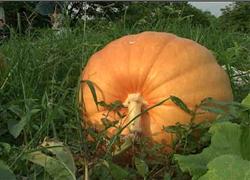Watering and fertilization methods of Pumpkin

The main results are as follows: (1) the watering pumpkin has strong root system, strong water absorption and drought resistance. Pumpkin has large and many leaves and exuberant transpiration, so it is necessary to irrigate at the right time in order to obtain high yield. (2) fertilization should be carried out according to the fertilizer requirements of pumpkin. Pumpkin growth period is different, the amount of nutrients absorbed is also different. In the seedling stage, the growth of pumpkin is very small, and the amount of fertilizer required is also less. during the fruit expansion stage, the absorption of nitrogen increases sharply, and the absorption rules of potassium and nitrogen are basically the same. However, the amount of phosphorus uptake increased less. According to the agricultural experiment in Miyazaki, Japan, during the 137 days from planting to pulling seedlings, the absorption of nitrogen, phosphorus, potassium, calcium and magnesium by pumpkin increased slowly in the first one, and increased rapidly in the middle one, especially in the last one. During the whole growth period, potassium and nitrogen were the most absorbed by pumpkin, followed by calcium, magnesium and phosphorus. To produce 4308 kg pumpkin per 667m2, it needs to absorb 20.5kg of nitrogen, 6.9kg of phosphorus pentoxide and 25.1 kg of potassium oxide. Specific fertilization requirements are as follows. ① base fertilizer. Mainly organic fertilizer, combined with nitrogen, phosphorus and potassium compound fertilizer. The commonly used base fertilizers are stable manure, compost or green manure, with a large amount of fertilizer, accounting for 1 / 2 of the total amount of fertilizer, and 3000-4000 kg of organic fertilizer per 667m2. All or most of the phosphorus and potassium fertilizers are used as base fertilizers and mixed with organic fertilizers into the soil layer. in the case of insufficient organic fertilizers, 15-20 kg of nitrogen, phosphorus and potassium compound fertilizers are applied for every 667 square meters. There are two methods of spreading and concentrated application of base fertilizer. Spreading is generally combined with deep ploughing. After evenly spreading organic fertilizer or compound fertilizer, rake twice with screw plough to make fertilizer and soil mix evenly. When there is less fertilizer, it is generally used to ditch and concentrate on the application of fertilizer in the sowing line. ② topdressing. Topdressing is mainly available nitrogen fertilizer, combined with phosphate fertilizer and potassium fertilizer. The amount of topdressing generally accounts for 1 / 2 / 3 of the total amount of fertilizer application. Topdressing should be carried out in batches according to the amount of nitrogen, phosphorus and potassium needed in different growth stages of pumpkin. Nitrogen fertilizer is the main topdressing fertilizer at seedling stage, which aims to promote seedling growth. Generally, 5-8 kg of urea is applied every 667 square meters. During the fruiting period, not only sufficient nitrogen fertilizer should be supplied, but also phosphorus and potassium fertilizer should be replenished in time to ensure the full expansion of the fruit. Generally, after setting the fruit, 10-15 kg of urea and 5-10 kg of potassium sulfate are applied every 667 square meters for a total of 1-2 times. Attention should be paid to the position when topdressing, topdressing should be applied near the base of the plant in the seedling stage, and in the fruiting stage, the position of topdressing should gradually move to both sides of the border. In calcareous soil, nitrogen fertilizer should abide by the fertilization principle of deep covering soil, especially ammonium bicarbonate, covering soil must be applied more than 6 cm deep, so as to avoid fertilizer volatilization and reduce fertilizer efficiency. Ammonium sulfate, urea and other chemically stable nitrogen fertilizers can be topdressing by sprinkling combined with irrigation. In the middle and later stages of pumpkin growth, the ability of root system to absorb nutrients is weakened. in order to ensure the growth and development of pumpkin, extra-root topdressing can be used to supplement nutrients. The fertilizers sprayed can use 0.2% Mel 0.3% urea, 0.5% Mel 1% chlorine fertilizer, 0.2% Rue 0.3% potassium dihydrogen phosphate, generally sprayed once every 7-10 days, and several fertilizers can be applied alternately for 2-3 times.
- Prev

Key points of yield increasing technique of pumpkin multi-plant joint grafting
Too much nitrogen fertilizer in the early growth stage can easily lead to excessive growth of plants, resulting in flower and fruit drop phenomenon, which can not ensure the uniformity and final product quality of melon. Therefore, it is necessary to control the amount of nitrogen fertilizer used and appropriately increase the proportion of phosphorus and potassium fertilizer. When needed, can be treated by pharmaceutical methods, can choose zucchini fruit king 1...
- Next

Soil cultivation techniques of Giant Pumpkin
1. Seedling cultivation: 1. Nutrition bag seedling cultivation: seeds are sown in greenhouse 6 weeks before planting. The first step: put the seeds in 60 degrees hot water, stir for 15 minutes, until the water temperature drops to 35 degrees, and then soak for 12 hours; the second step: put the soaked seeds on the hotbed for germination, the time is 2.
Related
- Where is it suitable to grow horseradish in China? it is expected to see the middle altitude horseradish in Alishan.
- How to prevent tomato virus disease reasonably? (Control methods included)
- Many people like to plant towel gourd on the balcony. What are the main points of this method and management?
- What crops can chili peppers be mixed with?
- Fertilization techniques and matters needing attention in Tomato
- What are the grafting techniques for peach seedlings in spring?
- Harm and control methods of root swelling disease of Chinese cabbage
- What are the pests of sweet potatoes? How to prevent and cure it?
- Symptoms, causes and Control methods of navel Rot in Tomato
- The cause of "Cucumber rotten bibcock" in Farmers' planting Cucumber and its Control Plan

